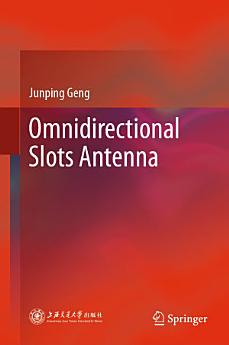Omnidirectional Slots Antenna
ធ្នូ 2020 · Springer Nature
សៀវភៅអេឡិចត្រូនិច
170
ទំព័រ
reportការវាយតម្លៃ និងមតិវាយតម្លៃមិនត្រូវបានផ្ទៀងផ្ទាត់ទេ ស្វែងយល់បន្ថែម
អំពីសៀវភៅអេឡិចត្រូនិកនេះ
Omnidirectional antenna with high gain, low profile, vertical polarization, even CP polarization is very difficult to design, although it is from the dipole. In this book, a novel idea that the running wave in the coaxial wire is disturbed by the orthogonal slot array on the cylindrical metal shell is introduced, which radiates the CP wave in omni-direction. When feeding on two ends of the coaxial wire respectively, there will appear left hand circularly polarized (LHCP) omnidirectional radiation or right hand circularly polarized (RHCP) omnidirectional radiation. By introducing the T-shaped feed structure, the coaxial wire with slot array can conveniently produce the LHCP and RHCP radiation diversity with one end feeding. In the further, combining with the directional antenna, it will generate the pattern diversity in the half-sphere space. The antenna of the coaxial wire with slot array can further transform into conical CP beam antenna if the coaxial wire becomes into a conical frustum. By introducing the PIN diode into the slot, the antenna of the coaxial wire with slot array can radiate the reconfigurable directional beam by switching the states of the PIN diodes. By introducing a novel switchable microwave circuit, the omnidirectional /directional pattern switchable antenna can be realized easily.This book proposes a continues method to develop the potentialities of the omnidirectional antenna. And the readers can study the method or ideas of the omnidirectional slots antenna, even graft the CP or diversity methods to other antennae.
អំពីអ្នកនិពន្ធ
Dr. Junping Geng received his B.E degree in plastic working of metals, M.S. degree in corrosion and protection of equipment, and Ph.D. degree in circuit and system from the Northwestern Polytechnic University, Xian, China, in 1996, 1999, and 2003, respectively.From 2003 to 2005, he was a Postdoctoral Researcher with Shanghai Jiao Tong University, Shanghai, China. In April 2005, he joined the faculty of the Electronic Engineering Department, Shanghai Jiao Tong University. He was promoted to an associated professor in 2008.From 2010 to 2011, he was a visiting scholar with the Institute Electrical and Computer Engineering, University of Arizona, AZ, USA.Besides, he is among the editorial board of International Journal of Antenna and Propagation and International Journal of Aerospace Engineering. He is also a member of Antenna Society of Chinese Institute of Electronics. And he has been the Senior member of IEEE in 2017.
He is mainly engaged in the teaching and research work on the fields covering antenna and electromagnetic theory, array signal processing, wireless communications, and nano technology, etc. In 2015, he received the best paper award in IEEE MAPE 2015. In 2013, he was awarded the third rank of Shanghai Award for Natural Sciences. In 2010, he received the best paper award in IEEE iWAT2010. In 2008, he won the second prize of Chinese National Technology Innovation Awards as the third co-author. In 2007, he won the first prize of Technology Innovation Awards of the Ministry of Education as the fourth co-author. In 2009, he won the second Prize of "Hengshan Liangci" Excellent Paper.He won the Shanghai Jiao Tong University excellent annual assessment in 2007, 2014, 2016, 2017, and 2018 respectively, and he also won the third prize for excellent teachers in 2008, excellent in the appointment period 2014-2016 in Shanghai Jiaotong University too. He won the third prize of postdoctoralaward fund in 2006.
So far he had published over 350 papers at home and abroad, about 127 of them in International Journals. He has applied over 120 invention patents, and 71 of them have been granted. Also, he has published a text book and three monographs. He has served as an associate editor for International Journal of Antennas and Propagations, member of Technology Program Committee (TPC) and session chair for more than 15 international conferences.He has been in charge of or involved in over 30 projects including Chinese National Fund, the State Key Program of National Natural Science, 973, Innovation group and Shanghai Research Projects.
He is mainly engaged in the teaching and research work on the fields covering antenna and electromagnetic theory, array signal processing, wireless communications, and nano technology, etc. In 2015, he received the best paper award in IEEE MAPE 2015. In 2013, he was awarded the third rank of Shanghai Award for Natural Sciences. In 2010, he received the best paper award in IEEE iWAT2010. In 2008, he won the second prize of Chinese National Technology Innovation Awards as the third co-author. In 2007, he won the first prize of Technology Innovation Awards of the Ministry of Education as the fourth co-author. In 2009, he won the second Prize of "Hengshan Liangci" Excellent Paper.He won the Shanghai Jiao Tong University excellent annual assessment in 2007, 2014, 2016, 2017, and 2018 respectively, and he also won the third prize for excellent teachers in 2008, excellent in the appointment period 2014-2016 in Shanghai Jiaotong University too. He won the third prize of postdoctoralaward fund in 2006.
So far he had published over 350 papers at home and abroad, about 127 of them in International Journals. He has applied over 120 invention patents, and 71 of them have been granted. Also, he has published a text book and three monographs. He has served as an associate editor for International Journal of Antennas and Propagations, member of Technology Program Committee (TPC) and session chair for more than 15 international conferences.He has been in charge of or involved in over 30 projects including Chinese National Fund, the State Key Program of National Natural Science, 973, Innovation group and Shanghai Research Projects.
វាយតម្លៃសៀវភៅអេឡិចត្រូនិកនេះ
ប្រាប់យើងអំពីការយល់ឃើញរបស់អ្នក។
អានព័ត៌មាន
ទូរសព្ទឆ្លាតវៃ និងថេប្លេត
ដំឡើងកម្មវិធី Google Play Books សម្រាប់ Android និង iPad/iPhone ។ វាធ្វើសមកាលកម្មដោយស្វ័យប្រវត្តិជាមួយគណនីរបស់អ្នក និងអនុញ្ញាតឱ្យអ្នកអានពេលមានអ៊ីនធឺណិត ឬគ្មានអ៊ីនធឺណិតនៅគ្រប់ទីកន្លែង។
កុំព្យូទ័រយួរដៃ និងកុំព្យូទ័រ
អ្នកអាចស្ដាប់សៀវភៅជាសំឡេងដែលបានទិញនៅក្នុង Google Play ដោយប្រើកម្មវិធីរុករកតាមអ៊ីនធឺណិតក្នុងកុំព្យូទ័ររបស់អ្នក។
eReaders និងឧបករណ៍ផ្សេងទៀត
ដើម្បីអាននៅលើឧបករណ៍ e-ink ដូចជាឧបករណ៍អានសៀវភៅអេឡិចត្រូនិក Kobo អ្នកនឹងត្រូវទាញយកឯកសារ ហើយផ្ទេរវាទៅឧបករណ៍របស់អ្នក។ សូមអនុវត្តតាមការណែនាំលម្អិតរបស់មជ្ឈមណ្ឌលជំនួយ ដើម្បីផ្ទេរឯកសារទៅឧបករណ៍អានសៀវភៅអេឡិចត្រូនិកដែលស្គាល់។





